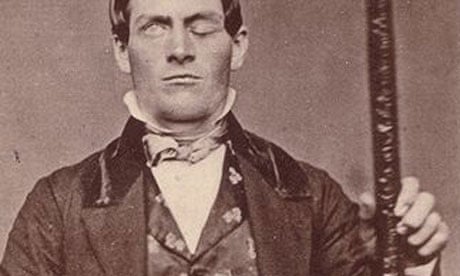The photograph above, which was uncovered earlier this year, is one of only two known images of an otherwise unremarkable man named Phineas Gage who attained near-legendary status in the history of neuroscience and psychology one fateful day in 1848 at the age of 25.
Gage earned his place in the neurological hall of fame in a most unusual – and extremely unfortunate – way. A railroad construction foreman in the US, he was in charge of a crew of men who were working on the construction of the Rutland and Burlington Railroad near Cavendish, Vermont. On 18 September, he and his crew were excavating rocks to make way for the railroad. Gage was preparing for an explosion, using the tamping iron he holds in the photograph to compact explosive charge in a borehole. As he was doing so, the iron produced a spark that ignited the powder, and the resulting blast propelled the tamping iron straight through his head.
John Harlow, the physician who attended to Gage at the scene, noted that the tamping iron was found some 10 metres away, "where it was afterward picked up by his men, smeared with blood and brain". He provides a detailed description of the "hitherto unparalleled case" in a letter to the editor of the Boston Medical and Surgical Journal, entitled "Passage of an Iron Rod Through the Head":
[The tamping iron] entered the cranium, passing through the anterior left lobe of the cerebrum, and made its exit in the medial line, at the junction of the coronal and sagittal sutures, lacerating the longitudinal sinus, fracturing the parietal and frontal bones extensively, breaking up considerable portions of the brain, and protruding the globe of the left eye from its socket, by nearly half its diameter.
Remarkably, Gage survived this horrific ordeal, and by all accounts was conscious and walking within minutes. Back at Gage's nearby lodgings, Harlow removed small bone fragments from the wounds, replaced larger fragments that had been displaced by the passage of the tamping iron, and closed the large wound at the top of Gage's head with adhesive straps.
Several days later, one of the wounds became infected and he fell into a semi-comatose state. Fearing the worst, his family prepared a coffin, but Gage soon recovered and by January 1849 was leading an apparently normal life. But those closest to him began to notice dramatic changes in his behaviour. Twenty years later, Harlow described the "mental manifestations" of Gage's injury in the Bulletin of the Massachusetts Medical Society:
His contractors, who regarded him as the most efficient and capable foreman in their employ previous to his injury, considered the change in his mind so marked that they could not give him his place again. He is fitful, irreverent, indulging at times in the grossest profanity (which was not previously his custom), manifesting but little deference for his fellows, impatient of restraint of advice when it conflicts with his desires, at times pertinaciously obstinent, yet capricious and vacillating, devising many plans of future operation, which are no sooner arranged than they are abandoned in turn for others appearing more feasible. In this regard, his mind was radically changed, so decidedly that his friends and acquaintances said he was "no longer Gage".
Similarly, most popular accounts of Phineas Gage describe him as having undergone profound personality changes because of his injury. He is often reported as having permanently lost his inhibitions, so that he started to behave inappropriately in social situations. Some reports state that became violent and "uncontrollable", and even that he started to molest children.
We actually know next to nothing about Gage's personality before the injury, so it is difficult to understand exactly how it changed afterward, and the story is further complicated by our incomplete knowledge of the extent of his injury. Despite this, the case of Phineas Gage has been used and abused ever since it first appeared. Neurologists have cited it as evidence in support their pet theories, and even creationists have been known to cite it as evidence that personality is not a product of brain function.
According to psychologist Malcolm Macmillan, however, many of the reports are inconsistent and unsubstantiated by the evidence. Macmillan's research suggests that the behavioural changes observed in Gage lasted for only a short time after the injury. "Phineas' story," he writes in his book An Odd Kind of Fame, "is worth remembering because it illustrates how easily a small stock of facts becomes transformed into popular and scientific myth."
Of Gage's subsequent life, we also know very little. He is said to have travelled around the larger towns in New England, making public appearances with his tamping iron, to which he had apparently become curiously attached. Harlow states that he exhibited himself in Barnum's American Museum in New York City, where people would presumably have paid to see him, but this has not been confirmed.
Ultimately, it is impossible to separate the facts of this extraordinary story from the fictions. Regardless, Gage's was the first – and arguably the most important – case to reveal that some faculties can be associated with specific regions of the brain. Despite the exaggerated stories and fabrications, Gage taught us that complex functions such as decision-making and social cognition are largely dependent upon the frontal lobes.
What does seem well established is that he managed to hold down several jobs in the years following his injury. He worked in a livery stable in Hanover, New Hampshire, and later as a long-distance coach driver on the Valparaiso-Santiago route in Chile. He left Chile for California around 1859, where he worked for a short time on a small farm in Santa Clara.
At around this time, Gage apparently started to experience convulsions of increasing severity, and consequently died in 1860, somewhere near San Francisco. His skull is now kept at the Warren Anatomical Museum at Harvard Medical School, alongside the tamping iron that penetrated it, which is inscribed as follows:
This is the bar that was shot through the head of Mr Phinehas [sic] P. Gage at Cavendish, Vermont, Sept. 14 [sic], 1848. He fully recovered from the injury & deposited this bar in the Museum of the Medical College of Harvard University. Phinehas P. Gage Lebanon Grafton Cy N-H Jan 6 1850.
Mo Costandi writes the Neurophilosophy blog
Further reading
Macmillan, M. (2008) Phineas Gage – Unravelling the myth. The Psychologist; 21: 828-831.








Comments (…)
Sign in or create your Guardian account to join the discussion